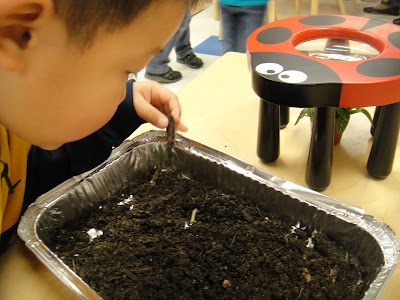It can be tempting (and simpler) to impose many structures on you young children and in classrooms. As child-centered as I believe I am - I have come to realize that I am hesitant to relinquish too much control. I've been reading Making Learning Visible by Project Zero and Reggio Children and it has provoked a great deal of thinking, especially in terms of time, space, transitions, and control. I truly believe that when we're lucky enough to be inspired by something read, heard, or thought of in a moment of clarity that you just have to go for it...or chances are you won't ever again.
So this is what I did. After a weekend of perusing Making Learning Visible I came to school intent on letting the children determine a great deal about time and space - the goal for us all to be in control of our own learning.
During our play in centers, I have an urge to contain centers. You know builders stay in the block area, writers stay in the communication area. The provocation for me was in reading "Many group activities are taking place at once. The children move from being protagonists in one activity to being audience in another, an audience that helps and learns, thereby becoming a competent audience." I'm curious how other educators navigate this idea of movement during play and project work.
The images below, share a story of one child intensely interested in the observation of worms and meal worms and the ebb and flow of friends becoming participants along the way.

First thing in the morning, as we welcome children to school one child chooses to sit at the observation table, where worms and a new tabletop magnifying class are laid out as a provocation. Other children pass by, a few linger longer, but only one child remains for the full morning arrival time.

During our morning meeting I asked children about their plans for the day. They decided a terrarium created from recycled materials and brought in by our friend needed more details so a few got to work, another group who began building a castle in the morning determined they needed to continue their work, and our worm observer was eager to get back to watching. So he did…along with one more friend.

Soon, another child appeared. At first watching and then her fingers gently pushing aside soil searching for a sign of life, “I see a cocoon, a cocoon” she said. Followed by another voice “You know how I know it has a baby? When I touch it on the bottom with the stick I see it.” Their interest in these tiny creatures, has been since the beginning, a desire to know if they have families like us. Big worms are daddies and when worms are side by side they are often labeled as mommy and baby. This forging of a personal connection is still present – even after we have read nonfiction books about worms informing us that, in fact, they do not live with families like us.

The excitement of finding a cocoon (spoiler alert it’s a pebble) quickly drew an audience of two more friends. They watched at first and soon began vying for space, fingers in the soil searching.
They leave , called back to their castle creation by their friends, “we’re making a roof, come on.”

The observation pioneers for the day, just two. A full circle.
No comments:
Post a Comment